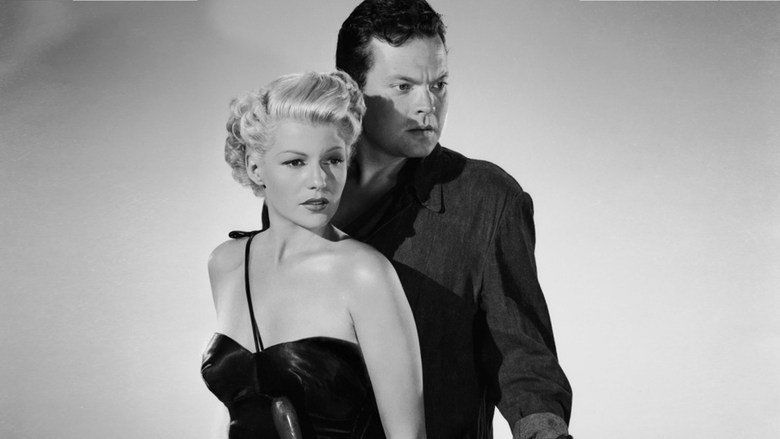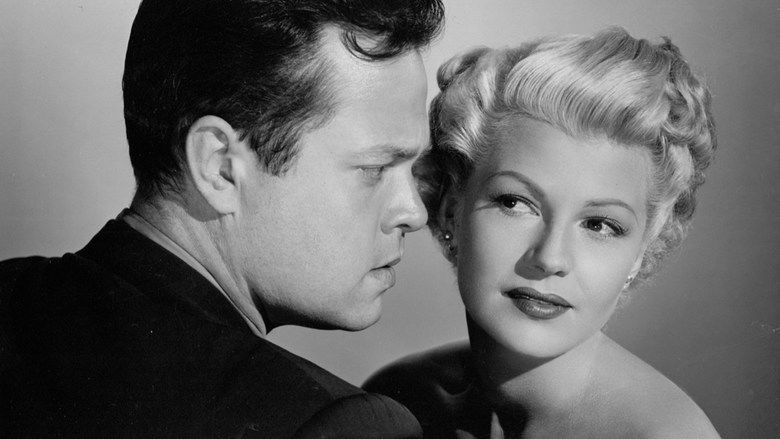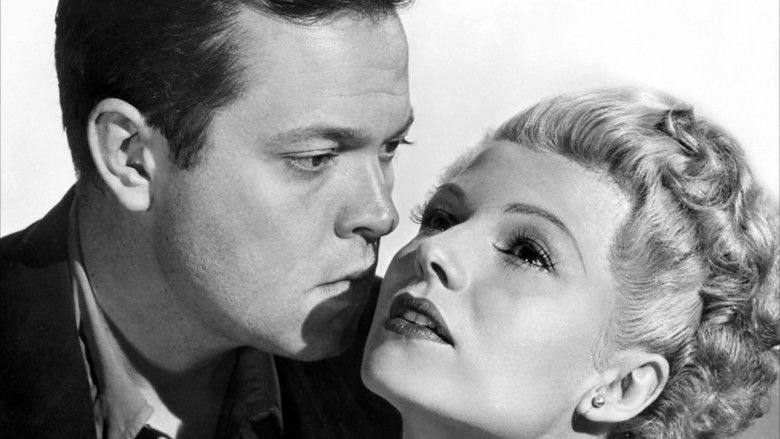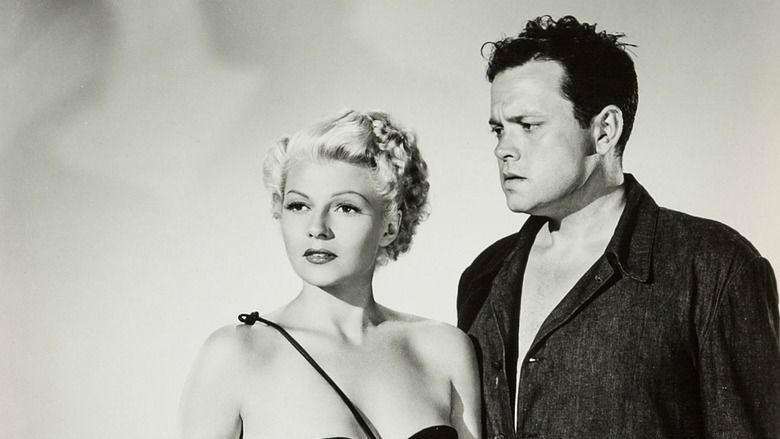The Lady from Shanghai
8 /10 1 Votes8
Genre Crime, Drama, Film-Noir Country United States | 7.8/10 IMDb Duration Language English | |||||||||||||||||||||||||||||||||
 | ||||||||||||||||||||||||||||||||||
Release date December 24, 1947 (France)June 9, 1948 (US) Based on If I Die Before I Wake1938 novel by Sherwood King Initial release December 24, 1947 (France) Cinematography Charles Lawton, Rudolph Mate, Joseph Walker Cast (Elsa Bannister), Orson Welles (Michael O'Hara), (Arthur Bannister), (George Grisby), (Sidney Broome), (Judge)Similar movies The Big Sleep , Double Indemnity , Around the World in 80 Days , Sea of Love , Vertigo , The Talented Mr. Ripley Tagline I told you... you know nothing about wickedness | ||||||||||||||||||||||||||||||||||
The lady from shanghai trailer
The Lady from Shanghai is a 1947 film noir directed by Orson Welles and starring Welles, his estranged wife Rita Hayworth and Everett Sloane. It is based on the novel If I Die Before I Wake by Sherwood King.
Contents
- The lady from shanghai trailer
- the lady from shanghai funhouse mirrors 1947 hd
- Plot
- Cast
- Production
- Filming locations
- Critical reaction
- In popular culture
- References

Although The Lady from Shanghai initially received mixed reviews, it has grown in stature over the years, and many critics have praised its set designs and camerawork.

the lady from shanghai funhouse mirrors 1947 hd
Plot

Irish sailor Michael O'Hara (Welles) meets the beautiful blonde Elsa (Rita Hayworth) as she rides a horse-drawn coach in Central Park. Three hooligans waylay the coach. Michael rescues Elsa and escorts her home. Michael reveals he is a seaman and learns Elsa and her husband, disabled criminal defense attorney Arthur Bannister (Sloane), are newly arrived in New York City from Shanghai. They are on their way to San Francisco via the Panama Canal. Michael, attracted to Elsa despite misgivings, agrees to sign on as an able seaman aboard Bannister's yacht.

They are joined on the boat by Bannister's partner, George Grisby (Glenn Anders), who proposes that Michael "murder" him in a plot to fake his own death. He promises Michael $5,000 and explains that since he would not really be dead and since there would be no corpse, Michael could not be convicted of murder (reflecting corpus delicti laws at the time). Michael agrees, intending to use the money to run away with Elsa. Grisby has Michael sign a confession.

On the eve of the crime, Sydney Broome (Ted de Corsia), a private investigator who has been following Elsa on her husband's orders, confronts Grisby. Broome has learned of Grisby's plan to actually murder Bannister, frame Michael, and escape by pretending to have also been murdered. Grisby shoots Broome and leaves him for dead. Unaware of what has happened, Michael proceeds with the night's arrangement and sees Grisby off on a motorboat before shooting a gun into the air to draw attention to himself. Meanwhile, Broome, injured but alive, asks Elsa for help. He warns her that Grisby intends to kill her husband.
Michael makes a phone call to Elsa, but finds Broome on the other end of the line. Broome warns Michael that Grisby was setting him up. Michael rushes to Bannister's office in time to see Bannister is alive, but that the police are removing Grisby's body from the premises. The police find evidence implicating Michael, including his confession, and take him away.
At trial, Bannister acts as Michael's attorney. He feels he can win the case if Michael pleads justifiable homicide. During the trial, Bannister learns of his wife's relationship with Michael. He ultimately takes pleasure in his suspicion that they will lose the case. Bannister also indicates that he knows the real killer's identity. Before the verdict, Michael escapes by feigning a suicide attempt. Elsa follows. Michael and she hide in a Chinatown theater. Elsa calls some Chinese friends to meet her. As Michael and Elsa wait and pretend to watch the show, Michael realizes that she killed Grisby. Elsa's Chinese friends arrive and take Michael, unconscious, to an abandoned Fun House. When he wakes, he realizes that Grisby and Elsa had been planning to murder Bannister and frame him for the crime, but that Broome's involvement ruined the scheme and that Elsa had to kill Grisby for her own protection.
The film features a unique climactic shootout in a hall of mirrors involving a multitude of false and real mirrored images in the Magic Mirror Maze, in which Elsa is mortally wounded and Bannister is killed. Heartbroken, Michael leaves presuming that events which have unfolded since the trial will clear him of any crimes. "Maybe I'd forget her. Maybe I'd die trying".
Cast
Production
In the summer of 1946, Welles was directing a musical stage version of Around the World in Eighty Days, with a comedic and ironic rewriting of the Jules Verne novel by Welles, incidental music and songs by Cole Porter, and production by Mike Todd, who would later produce the successful film version with David Niven.
When Todd pulled out from the lavish and expensive production, Welles financed it. When he ran out of money and urgently needed $55,000 to release costumes which were being held, he convinced Columbia Pictures president Harry Cohn to send him the money to continue the show and in exchange Welles promised to write, produce and direct a film for Cohn for no further fee. As Welles tells it, on the spur of the moment, he suggested the film be based on a book that he happened to see in front of him during his call with Cohn, one a girl in the theatre box office was reading at the time. Welles had never read it. However, according to the daughter of William Castle, it was her father who had purchased the film adaptation rights for the novel and who then asked Welles to pitch it to Cohn, with Castle hoping to receive the directoral assignment himself. She described her father as greatly respecting Welles' talents, but feeling nonetheless disappointed at being relegated to serve merely as Welles' assistant director on the film.
The Lady from Shanghai began filming on 2 October 1946, and originally finished filming on 27 February 1947, with studio-ordered retakes continuing through March 1947—but it was not released in the U.S. until 9 June 1948. Cohn strongly disliked Welles's rough cut, particularly what he considered to be a confusing plot and lack of close-ups (Welles had deliberately avoided these, as a stylistic device), and was not in sympathy with Welles's Brechtian use of irony and black comedy, especially in a farcical courtroom scene. He also objected to the appearance of the film—Welles had aimed for documentary-style authenticity by shooting one of the first major Hollywood pictures almost entirely on location (in Acapulco, Pie de la Cuesta, Sausalito and San Francisco) using long takes, and Cohn preferred the more tightly-controlled look of footage lit and shot in a studio. Release was delayed due to Cohn ordering extensive editing and reshoots. Whereas Welles had delivered his cut of the film on time and under budget, the reshoots Welles was ordered to do meant that the film ended up over budget by a third, contributing to the director's reputation for going over budget. Once the reshoots were over, the heavy editing ordered by Cohn took over a year to complete; veteran editor Viola Lawrence cut about an hour from Welles's rough cut. Welles was appalled at the musical score and particularly aggrieved by the cuts to the climactic confrontation scene in an amusement park funhouse at the end of the film. Intended as a climactic tour-de-force of editing and production design, the scene was cut to fewer than three minutes out of an intended running time of twenty. As with many of Welles's films over which he did not have control over the final cut, the missing footage has not been found and is presumed to have been destroyed. Surviving production stills show elaborate and expensive sets built for the sequence which were entirely cut from the film.
Welles cast his wife Rita Hayworth as Elsa and caused controversy when he made her cut her famous long red hair and bleach it blonde for the role. "Orson was trying something new with me, but Harry Cohn wanted The Image—The Image he was gonna make me 'til I was 90," Rita Hayworth recalled. "The Lady from Shanghai was a very good picture. So what does Harry Cohn say when he sees it? 'He's ruined you—he cut your hair off!'"
The film was considered a disaster in America at the time of its release, though the closing shootout in a hall of mirrors has since become one of the touchstones of film noir. Not long after release, Welles and Hayworth finalized their divorce.
A remake of the film came close to production at the turn of the century from a screenplay written by Jeff Vintar, based both on the Orson Welles script and the original pulp novel, produced by John Woo and Terence Chang, and starring Brendan Fraser, who wanted Michael Douglas and Catherine Zeta-Jones to co-star. Although the screenplay was considered highly successful, and Fraser was coming off the highly praised Gods and Monsters, the project was abandoned when the head of Sony Pictures, Amy Pascal, decided to concentrate on teen films.
Filming locations
In addition to the Columbia Pictures studios, the film was partly shot on location in San Francisco. It features the Sausalito waterfront and Sally Stanford's Valhalla waterfront bar and cafe, the front, interior, and a courtroom scene of the old Kearny Street Hall of Justice, and shots of Welles running across Portsmouth Square, escaping to a long scene in a theater in Chinatown, then the Steinhart Aquarium in Golden Gate Park, and Whitney's Playland-at-the-Beach amusement park at Ocean Beach for the famous hall of mirrors scene, for which interiors were shot on a soundstage.
Other scenes were filmed in Acapulco. The yacht Zaca, on which many scenes take place, was owned by actor Errol Flynn, who skippered the yacht in between takes and can also be seen in the background in one scene at a cantina in Acapulco.
Critical reaction
Reviews for The Lady from Shanghai were initially mixed. Variety magazine found the script wordy and noted that the "rambling style used by Orson Welles has occasional flashes of imagination, particularly in the tricky backgrounds he uses to unfold the yarn, but effects, while good on their own, are distracting to the murder plot."
A more recent Time Out Film Guide review states that Welles simply didn't care enough to make the narrative seamless: "the principal pleasure of The Lady from Shanghai is its tongue-in-cheek approach to story-telling." One recent book on Film Noir praises the film for its pervasive atmosphere of malaise and its impressive, extraordinary technical mastery.
Although The Lady From Shanghai was acclaimed in Europe, it was not embraced in the U.S. until several decades later. Review aggregator Rotten Tomatoes reports an 86% approval from critics, and an average rating of 8.1/10. Influential modern critics including David Kehr have subsequently declared it a masterpiece, with Kehr calling it "the weirdest great movie ever made." In the British Film Institute's 2012 Sight & Sound poll, six critics each ranked it one of the 10 greatest films of all time.
In popular culture
References
The Lady from Shanghai WikipediaThe Lady from Shanghai IMDb The Lady from Shanghai themoviedb.org
